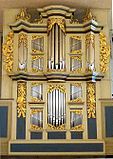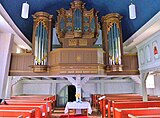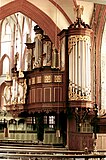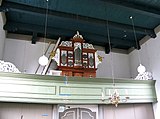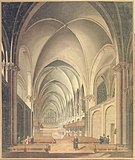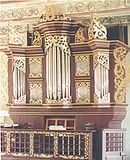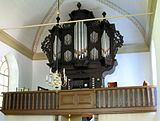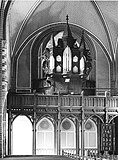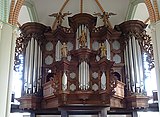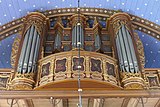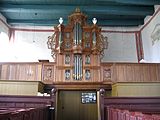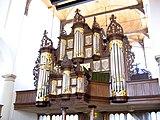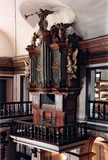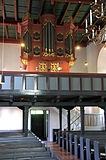Arp Schnitger

Arp Schnitger (* 1648 , probably in Schmalenfleth ; ~ July 9, 1648 in Golzwarden ; ⚰ July 28, 1719 in Neuenfelde ) was one of the most famous organ builders of his time and the finisher of the North German baroque organ . His sphere of activity extended across Northern Europe, where he created over 100 new organs and was a style-maker. In addition to the main workshop in Hamburg, journeymen and employees worked in branches between Groningen and Berlin in order to build new organs from there or to maintain or convert older works. Schnitger conceived his works with roaring mixtures and strong basses, on the one hand, for the accompaniment of the church singing. On the other hand, they served to represent the North German organ school , which could unfold in the evening music organized by the merchants in the Hanseatic cities . About 30 of his instruments are still preserved in their basic substance.
Life
Date of birth
The exact date of birth is not known. The now widespread statement that Schnitger was born on July 2, 1648 arises from a presumption by Schnitger researcher Gustav Fock . However, this cannot be supported due to a lack of evidence. His baptism date is documented on July 9, 1648 in the Golzwarder church .
origin

Arp Schnitger came from a respected family of carpenters who had lived in Schmalenfleth (Brake) for generations. The family name Schnitger indicates the trade of the family of origin: Arp Schnitger's grandfather Berendt was “Snitker” (Low German for “Schnitzer”), that is, a carpenter. The father Arp Schnitger sen. (* 1610 / 15–1680) was a master carpenter, but has also been proven during work on the Golzwarder organ. From his wife only the first name Katharina and the year of death (1674) have survived. The marriage had at least five children, of which Arp was likely the youngest. Until 1695 he mostly used the spelling "Schnitker" or "Schnittker", after which he preferred "Schnitger".
childhood and education
Little is known about Schnitger's childhood and education. He grew up with his siblings and probably learned the craft of his father (1662-1666). It is historically certain that from 1670 he was a journeyman with his relative Berendt Hus in Glückstadt on the Lower Elbe . Schnitger probably learned organ building there in the years 1666–1671. The completion of the Stader organ of St. Cosmae 1673 was a culmination of this phase of life. The lifelong friendship with Vincent Lübeck , who was organist at St. Cosmae from 1674–1702 and at Schnitger's largest organ in Hamburg's St. Nikolai Church from 1702–1740, was fruitful for Schnitger . After the death of his teacher in 1676, Schnitger completed the new organ in Stade in Stade at the age of 29 and continued the organ workshop, initially on behalf of the widow Hus, and from 1677 as an independent master.
Manual skill and sphere of activity

Word of Schnitger's manual and artistic skills quickly got around. He initially received orders from the local area, but soon there were also inquiries from Bremen and Hamburg . From 1677 to 1682 Schnitger worked in his Stade workshop and built some organs that had been commissioned from Hus. He then moved to Hamburg, began building Hamburg church organs in 1681 and became a full citizen of the Hanseatic city when he took his citizenship oath on September 1, 1682. In the same year he received his first major order from the parish council of St. Nikolai Church, for which he built an organ with 67 registers , four manuals , a pedal and more than 4,000 pipes. At that time this organ was probably the largest instrument in the world and established Schnitger's international fame. The largest pipe, the 32-footed C, weighed 860 pounds . This organ was destroyed in the Great Fire of Hamburg in 1842 . On the other hand, the organ rebuilt and partly rebuilt by Arp Schnitger in St. Jacobi (Hamburg) in 1689–93 still exists today with 60 stops, four manuals and pedal, one of the largest preserved baroque organs. Famous organ builders and composers visited this organ, including the organ master and composer Dieterich Buxtehude , probably Georg Friedrich Händel in 1703 and Johann Sebastian Bach in 1720 .
Schnitger's field of activity was mainly in northern Germany and the Netherlands , but extended over a large part of Europe:
- Northern Germany
- Netherlands, from 1691, where the city of Groningen (next to Stade and Hamburg) developed into a center for Schnitger and his school
- England , 1690 (one organ)
- Russia , 1691 (for Peter the Great ), 1697 an organ (house organ) for a private person, as well as other organs for at least two Protestant churches in the Moscow suburbs
- Denmark (probably), 1693 (one organ)
- Portugal , 1701 and later (four organs)
- Spain , after 1702 (one organ)
The whereabouts of the instruments shipped to England, Russia, Denmark and Spain is unknown.
In 1699 Schnitger was granted organ building privileges for the counties of Oldenburg and Delmenhorst , the duchies of Bremen and Verden, and in 1702 for Schleswig and Holstein . In 1708 Schnitger was appointed royal Prussian court organ builder, a position he held until 1714.
Family life
Schnitger's first marriage - marriage in 1684 in Hamburg - was married to the wealthy Hamburg merchant's daughter Gertrud Otte (1665–1707). In 1693 he acquired the farm of his father-in-law Hans Otte in Neuenfelde , where he moved to 1705 at the earliest and where he maintained another organ workshop until his death in 1719, the so-called “organ builder farm ”. He was buried on July 28, 1719 in the St. Pankratius Church in Neuenfelde, next to the pulpit in the family grave.
The marriage had six children. All four sons took up their father's occupation, but only two of them were to survive their important father and continue his work. Arp Schnitger jun. (1686–1712) installed the organ in Weener in 1710 and found a wife there, but died of the plague in Hamburg two years later . Hans Schnitger (1688–1708) drowned while bathing in the Elbe. Johann Jürgen (Georg) Schnitger (* 1690) took part in various organ projects and worked for a number of years on the organ in Zwolle with his brother Franz Caspar Schnitger . After 1734 all trace of him is lost. Franz Caspar Schnitger (1693–1729) worked after the death of his father in 1719 in the Netherlands, where he created important organs that are still preserved today in Meppel , Alkmaar and Zwolle. Arp Schnitger's eldest daughter Agneta only lived seven months (1685). His younger daughter Catharina (1697–1736) was married three times and lived on the “Orgelbauerhof” in Neuenfelde until her death.
Schnitger's first wife died in 1707. In 1712 or 1713 Schnitger married the organist widow Anna Elisabeth Koch, nee. Dieckmann from Abbehausen .
personality
No picture of Schnitger has been proven. Peter Golon has suggested that the picture of an organist with a wig and city skirt in the Golzwarder organ loft from 1701 could show the master from behind. In Golzwarden Schnitger had completely rebuilt an organ between 1697 and 1698 at cost price of 380 Reichstalers, "because I was born and baptized in this village". The Golzwarder painting is one of many paintings on the gallery parapet and has no further details that suggest an organ builder. In particular, no insignia of organ building art such as (proportional) circles and tuning horns are depicted, which were already represented in Schnitger's coat of arms (see above) in Neuenfelde. Schnitger's controversial identification with the portrayal of a musician on the gallery parapet below the organ who conducts an ensemble with a piano roll is also based on a chain of clues.
Schnitger grew up in a small village in Oldenburg. His correspondence testifies to an above-average general education, which also includes knowledge of Latin. It can therefore be assumed that Schnitger still attended the Golzwarder or Ovelgönner Latin school. He added the upscale “manu propria” to his signature instead of the usual “by hand”. For the second edition of Andreas Werckmeister's organ rehearsal (1698) he wrote a dedication poem with 12 pair rhymes in the Alexandrian . His far-sighted business acumen and economic competence can be seen in the coordination of the various outposts of the workshop, which flourished particularly around 1700.
His piety is particularly evident in his letters and organ contracts . The Soli Deo Gloria can be found on some of his organs and in most of his writings . According to Meijer’s report, Schnitger began his manuscripts with sentences like “In Jesu Name, Amen. - Glory to God alone. - Oh God, let me acquire an honest life and a blissful death. "
Schnitger is attested by various sides to be unselfish, especially in his Oldenburg homeland. He built some of his organs "for the glory of God" at cost price when the church congregations were not wealthy or made installments over many years. In 1699 he donated a one-manual organ to the Lutheran Church in Groningen. And when they showed their appreciation for 100 Reichstalers , he added a second manual and three new bellows . Schnitger's selflessness has come down to a personal testimony from his last years, when he had to endure many family blows and an economic decline. The organist Siwert Meijer from Groningen published three articles on Schnitger in the Dutch music magazine Caecilia in 1853/1854 , with which Arp Schnitger research began. He translated and paraphrased (apparently not always flawlessly) from Arp Schnitger's handwritten notes that were still available at the time and have since been lost. In it Schnitger also reported why he, as a famous organ builder, had not gotten rich anyway, because
"1. I never asked much, but when the churches did not have sufficient funds, I built organs for half the price for the glory of God; 2. Since I got a good name through my work, I was often referred to long distances, which caused a lot of expense; the rest of the to and fro has by no means been paid for; 3. Because of my multiple businesses in different places, I needed many journeymen; I myself could only be present in one place, which meant that most of the journeymen were only looking for their own advantage. After all, there were still expensive times during the long time it took to finish a great work, so that what I had earned in one work I lost again in the next. "
End of life
An exhausting trip to Zwolle in the winter of 1718/19, where Schnitger was negotiating a new organ, had badly affected his health. The date of his death has not been determined. He probably did not die in Neuenfelde, but in Itzehoe , where he had been building an organ with three manuals and 43 stops since 1715. Arp Schnitger's funeral is entered in the burial register of the Neuenfeld parish on July 28, 1719. He and his first wife and a daughter were buried in the Neuenfeld St. Pankratius Church, in which, in addition to his organ, his family's pews with the house brands of Schnitger and Otte and the baroque furnishings (pulpit altar) that were partly influenced by him were preserved . The church crypt was only rediscovered in 1971 and a simple stone slab was set into the floor to commemorate it.
plant
In total, Arp Schnitger built around 105 new organs, 30 significantly rebuilt and carried out 30 major repairs on organs. Around 30 of his works are still preserved today in a condition that justifies their designation as the "Arp Schnitger organ". His activities focused on the cities of Hamburg (23) and Bremen (9), the Elbe-Weser area (23), the county of Oldenburg (17), Magdeburg (7) as well as in the province (10) and city of Groningen (7 ). A total of over 30 organs were delivered outside of Germany. In addition to some works with four manuals, Schnitger has built 26 with three manuals and almost 20 larger two-manual organs with independent pedals. Around 3,000 newly built registers emerged from Schnitger's workshops.
The adjacent drawing for an organ prospectus (for the Academiekerk in Groningen, dated around 1698; this organ was transferred to the neighboring Der Aa-kerk in 1815/1816 ) is the only drawing with the dimensions "Hamburger Fuß" used by Schnitger that is still preserved (the 12-part scale can be seen under the design drawing).
Structural and sonic features
In terms of construction and sound, Schnitger's organs are characterized by the following features:
- The organs were handcrafted to the highest level. Schnitger often took over solidly built and excellent sounding basic voices from the previous organs if they could be integrated into his sound concept. The principals (in the case of precious works made of almost pure pewter) in the prospectus and the mixtures , however, he almost always made himself, sometimes also the reed parts .
- Work structure : As with his predecessors Gottfried Fritzsche and the organ builder family Scherer , Schnitger's instruments are divided into separate works according to the Hamburg prospectus (main work, Rückpositiv in the gallery parapet, pedal for larger organs in pedal towers, also chest positive and upper work). This takes up the Renaissance tradition of polychoralism . Schnitger organs are therefore ideally suited for the presentation of the North German organ school . Due to the richly arranged pedals, Schnitger's organs do not have pedal couplings . The pedal is attached to smaller organ works.
- The symmetrical prospect in the main work and in a reduced form in the Rückpositiv is characterized by a central polygonal bass tower and on the side by pointed towers in tenor position. In between, the pipes of the treble are arranged in mostly two-story flat fields . The pedal's pipework is housed laterally in separate pedal towers. In the case of late works in particular, there is a tendency for (silent) decorative flat panels to connect the pedal tower and the main work case, such as the organ in Pellworm (1711), in Sneek (1711) or Itzehoe (1719). The cornices, which are usually straight and not curved, are profiled and have crankings on the towers .
- Even small organs have a seamless principal choir as a powerful sound structure, which could be used to accompany the congregation singing, among other things. Two groups of multi-choir registers belong to it: (1) the two-choir aliquot register Sesquialtera and Terzian (with fifth and third chorus) as well as Rauschpfeife (summary of fifth 2 2 ⁄ 3 ′ and octave 2 ′) and (2) the sound crowns (Mixtur, Scharf ) with three to eight choirs. The third-octave registers of the first group are suitable both for solo registrations and for coloring the plenum . The sound crowns give the plenary session its characteristic brilliance. They consist of octave and fifth choirs, mostly with doubled choirs, often with an increasing number of choirs from bass to treble, and repeat several times. The top choir of the manual sound crowns is in the middle of the keyboard at 1 ′ or 2 ⁄ 3 ′. A special form - with appropriate registrations suitable for figurative passages - is the three-course fourth-sixth cymbal (Stade, Cappel, Norden, Hamburg / Jacobi). In the repetition it contains alternating fourth + sixth + octave and octave + third + fifth, starting with 3 ⁄ 16 ′ + 3 ⁄ 20 ′ + 1 ⁄ 8 ′.
- Compared to the Renaissance with its mostly wide-bored flute parts, Schnitger's flutes are much tighter, which results in a brighter and more elegant sound. On the other hand, an opposite development can be observed in the reeds; they are darker and more fundamental and emphasize the bass range. The reed choir is fully developed in the pedal. The tongues have the full length of the cup and are characterized by a good voice position. Their powerful and fundamental sound serves to support the community singing, which was only accompanied by the organ from the middle of the 17th century.
- The various individual stops are of great polyphonic quality. "The elegance of the response of the pipes, the harmonious relationship between fundamental and overtones, the ability to fuse principals and reeds as well as the different characters of the flutes combine to create an astonishing richness of sound." Compared to southern German organs, the large proportion of reed voices in Schnitger's works is striking (In the manuals also with short cups).
- As a rule, a mid-tone tuning is created in order to achieve great sound purity. Modifications towards a well-tempered mood only seem to have come (later) on express request . Such modifications are not detectable at Schnitger himself. With city organs, the disposition and intonation are generally more refined and refined than with village organs.
Schnitger's pupil
Schnitger had a total of around 50 students (journeymen) who continued his work in northern and central Germany , the Netherlands and Scandinavia . In addition to the main workshop in Hamburg, journeymen and employees worked in Stade, Bremen, Groningen, Lübeck , Magdeburg and Berlin in order to build new organs from there or to maintain or convert older works. These branch offices were headed by master craftsmen. As an entrepreneur, Schnitger himself traveled from workshop to workshop in order to conduct negotiations, design the organs and supervise the execution of the work. This procedure was also made possible by the fact that Schnitger used uniform lengths and construction methods. Thanks to these cost-cutting measures, it was also possible for small parishes to afford a new organ or larger organ reconstruction. Nevertheless, each organ was individually designed structurally and in terms of its disposition. Towards the end of Schnitger's life, various journeymen went into business for themselves and carried on the Schnitger tradition in Northern Europe. Otto Diedrich Richborn worked in Hamburg , Erasmus Bielfeldt in Stade (alleged student), Hans Hantelmann in Lübeck , Johann Dietrich Busch (alleged student) in Itzehoe , Christian Vater in Hanover , Johann Matthias Naumann and Andreas Müller in Hildesheim , Matthias Dropa in Lüneburg , in Westphalia Gerhard von Holy (presumed student), in Hessian Sontra Johann Adam Gundermann ( Wommen ), in Halle Christian Joachim , in Berlin and Silesia Johann Michael Röder and in Stettin Johann Balthasar Held . Gregorius Struve worked in Bremen, the Klapmeyer family of organ builders in Glückstadt and Oldenburg . Lambert Daniel Kastens (Itzehoe, Copenhagen and Norway ) and Eric German ( Stockholm ) worked in Scandinavia , and from 1711 Johann Hinrich Ulenkampf (Hulenkampf) in Portugal. Schnitger's influence in the Dutch provinces of Groningen and Friesland was even stronger and more lasting . After the early death of Franz Caspar Schnitger, Albertus Antonius Hinsz , who had married Franz Caspar's widow, took over the workshop in Groningen. After Hinsz, his student Heinrich Hermann Freytag took his place, who worked in partnership with Frans Casper Snitger jr. worked together. The Freytag family in the Netherlands carried on the tradition of Arp Schnitger for four generations until the workshop went out in 1863, so that Schnitger's works were preserved there more strongly than in Germany and were largely spared from major alterations. In addition, the Schnitger student Rudolf Garrels (Groningen and The Hague ) created important works in the Netherlands .
meaning
Schnitger's importance lies primarily in the craftsmanship, technical and tonal quality of his works. The organ in Hamburg's Nikolai Church in particular laid the foundation for his fame because of its size and sound characteristics. Schnitger did take over the multi-choir work principle of his predecessors, but developed it further into a large economy. Even in small village organs with a limited number of registers, there is a wide variety of sound options for individual voices, combinations and overall sounds, as the characteristic solo registers also have a great ability to merge harmoniously.
Schnitger designed his organs with roaring mixtures and strong basses, on the one hand, to accompany the congregation singing. On the other hand, they served to represent the North German organ school, as it could develop in particular in the evening music of the Hanseatic cities and other church music events outside of church services. The latter is clear from the admiration on the part of Vincent Lübeck, Dietrich Buxtehude and other contemporary organists, who were able to ideally realize the Stylus Phantasticus with its changing affects on Schnitger's organs. The work principle, the expanded principal choirs in all works, the colored or fundamental flute registers, the richly occupied reeds and the various plenums corresponded to the north German compositions with their frequent manual changes, consort registrations and the frequent use of the independent pedal.
Schnitger's international sphere of activity was unparalleled in his time. The 140 new buildings or conversions were essentially only made possible by Schnitger's efficient organization of various workshops. In addition, his numerous organ building privileges guaranteed him a monopoly in almost all of northern Germany.
Hardly any other organ builder has had such a great influence on modern organ building as Schnitger. The organ movement received its main impetus from 1925 onwards from the rediscovery of the organ in Hamburg's Jacobi Church. In recent years, almost all of the works that have survived have been restored according to the knowledge available today. Largely preserved and expertly restored works can be found in Cappel, Dedesdorf , Grasberg , Groningen (Aa-kerk) , Hamburg (St. Jacobi), Lüdingworth , Neuenfelde , Norden , Steinkirchen and Uithuizen . Organ builder Jürgen Ahrend ( Leer-Loga ) played a leading role in the restoration work . Many of Schnitger's works were reproduced in Germany, France , the Netherlands, Sweden , Switzerland and the United States or served as a source of inspiration for new buildings. "Schnitger's work has shaped the style of modern, historical models around the world." Today, the Arp Schnitger Society and the Dutch "Stichting Groningen Orgelland" are trying to research Schnitger's life and work and preserve his existing ones Organs and opening up its meaning to the general public. Since 2010, the Bremen Music Festival has been working on the recognition of the preserved Schnitger organs as UNESCO World Heritage on the 300th anniversary of the organ builder's death in 2019.
List of works
This list contains all new organs in which the registers or the case by Arp Schnitger have been preserved, as well as a selection of his destroyed organs or organs that have been replaced by new organs.
The size of the instruments is indicated in the fifth column by the number of manuals and the number of sounding registers in the sixth column. A capital “P” stands for an independent pedal, a lowercase “p” for an attached pedal. Italics indicate that the organ in question is no longer available or that only the prospectus is from Schnitger.
| year | place | church | image | Manuals | register | Remarks |
|---|---|---|---|---|---|---|
| 1668 - 1675/1688 | Stade | St. Cosmae et Damiani | III / P | 42 | Collaboration on and completion of the Berendt Hus organ; Housing, prospectus and 35 registers (eight of them partially) preserved; 1972–1975 restored by Jürgen Ahrend → organ from St. Cosmae et Damiani (Stade) |
|
| 1677 | Borstel (Jork) | St. Nikolai | II / P | about 20 | New building using several registers from the 16th century; extensive alterations in 1770/1771 by Johann Paul Geycke and 1848/1849 by Philipp Furtwängler ; a pedal register from Schnitger received | |
| 1677-1679 | Bülkau | St. John the Baptist | I. | at 10 | Housing and prospectus received; today II / P / 22 | |
| 1678 - 1679/1709 | Jork | St. Matthias |

|
III / P | 35 | Extension of the organ by a free pedal (1678–1679); Case and prospectus (1709) preserved; today II / P / 22 |
| 1680 | Hamburg (today in Cappel ) | St. Johannis, church of the former Johanniskloster | II / P | 30th | Dismantled in Hamburg in 1813 and transferred to Cappel (Lower Saxony), St. Peter and Paul in 1816; Case, prospectus (with original pipes) and 18 registers from Schnitger preserved; ten other old registers taken from Schnitger; 1976–1977 / 2009 restored by Rudolf von Beckerath Orgelbau → Organ by St. Peter and Paul (Cappel) |
|
| 1678-1682 | Oederquart | St. Johannis |

|
III / p | 28 | Extension of the organ by Hans Christoph Fritzsche (1652); Housing and original prospect pipes preserved; 2013–2017 reconstruction by Rowan West |
| 1682-1683 | Ludingworth | St. Jacobi Church |

|
III / P | 35 | Major extension of the organ by Antonius Wilde (1597–1598); Case, prospectus and 14 registers from Schnitger (in whole or in part) preserved; many old registers taken over from Schnitger (half of the total registers); 1981–1982 restored by Jürgen Ahrend → Organ of St. Jacobi Church (Lüdingworth) |
| 1684 | Elmshorn | St. Nicholas Church |

|
II / P | 23 | Completion of the new building by Joachim Richborn , whose housing has been preserved; today III / P / 33 |
| 1686 or later | Hamburg- Bergstedt | Bergstedt Church | I. | 8th | Organ positive; Case and two to three registers from Schnitger preserved → Organs of Bergstedt Church |
|
| 1686-1687 | Hamburg-Altona (today in Blankenhagen ) | Blankenhagen village church | II / p | 12 | In 1833 transferred to the village church of Blankenhagen; Case and four to five registers preserved from Schnitger; Restored in 2003 by Alexander Schuke → Organ of the Blankenhagen village church |
|
| 1682-1687 | Hamburg | St. Nikolai | IV / P | 67 | Destroyed in the Hamburg fire in 1842 | |
| 1685-1687 | Stone churches | St. Martini et Nicolai | II / P | 28 | Case, prospectus, 18 registers (six of which have been taken over in full or in part) and six others have been partially preserved; 1947–1948 and 1987/1991 restored by Rudolf von Beckerath → organ by St. Martini et Nicolai (Steinkirchen) |
|
| 1683-1688 | Hamburg- Neuenfelde | St. Pancras |

|
II / P | 34 | Housing, prospectus and 18 registers preserved; Restoration 2015–2017 by the Wegscheider organ workshop → Organ by St. Pankratius (Neuenfelde) |
| 1688 | Mittelkirchen | St. Bartholomew | II / p | 21st | six to eight registers preserved from Schnitger; today II / P / 30; 2010–2011 restored by Bartelt Immer → Organ from St. Bartholomäus (Mittelkirchen) |
|
| 1688-1690 | Hollern | St. Mauritius | II / P | 24 | Housing, prospectus and 13 registers preserved (in whole or in part); 2010–2011 restored by Hendrik Ahrend → Organ from St. Mauritius (Hollern) |
|
| 1686 - 1688/1691 - 1692 | north | St. Ludgeri | III / P (IV / P) | 46 | Case and 13 registers from Schnitger preserved; eight other old registers taken from Schnitger; 1981–1985 restored by Jürgen Ahrend → Organ of the Ludgerikirche (north) |
|
| 1691-1692 | Groningen (NL) | Martinikerk | III / P | 39 | Pedal case, brochure and six registers from Schnitger preserved; other old registers taken from Schnitger; today III / P / 52; 1976–1977 and 1983–1984 restored by Jürgen Ahrend → Organs of the Martinikerk (Groningen) |
|
| 1689-1693 | Hamburg | St. Jacobi | IV / P | 60 | 43 registers preserved (in whole or in part); several old registers taken from Schnitger; 1990–1993 restored by Jürgen Ahrend → organ of the main church Sankt Jacobi (Hamburg) |
|
| 1693 | Groningen (NL) | Pelstergasthuiskerk | II / p | 20th | Case and two registers completely and seven partially preserved; 1989–1990 restored by Bakker & Timmenga → Organ of the Pelstergasthuiskerk Groningen |
|
| 1693 | Eutin Castle | Castle chapel |

|
II / P | about 23 | Housing preserved; today I / 9 |
| 1693-1694 | Hamburg (today in Grasberg ) | Orphanage | II / P | 21st | 1788 to Grasberg, Ev.-luth. Church, convicted; Housing and 14 registers preserved; 1980–1985 restored by Gebr. Hillebrand → Organ of the Grasberg Church |
|
| 1694 | Hamburg (today in Deyelsdorf ) | Originally a house organ for Johann Friedrich Mayer | I. | 8th | probably since 1741/1742 in the Deyelsdorf church ; Identification and attribution 2014 by Jan von Busch. Housing, two registers (Gedackt 8 'and Flute 4') and the g ° of Principal 4 'have been preserved. Original disposition: Principal 4 ′, Gedackt 8 ′, Flute 4 ′, Sesquialtera and four other registers, including probably an Octave 2 ′. Extent probably CDE – c 3 . Tuning pitch: Chorton (a 1 = around 465 Hz) | |
| 1690-1695 | Magdeburg | St. Johannis | III / P | 62 | Replaced in 1870 by a new building designed by Wilhelm Sauer | |
| 1695 | Nieuw Scheemda (NL) | Dorpskerk | I / p | 8th | Housing and two registers completely and 3 partially preserved; Restored 1968 by Orgelbau Metzler & Söhne , 1988 by Bernhardt Edskes → Organ of the Dorpskerk Nieuw Scheemda |
|
| 1695-1696 | Noordbroek (NL) | Dorpskerk | II / P | 20th | partly rebuilt case and ten to eleven registers preserved; today II / P / 24; 1955 Disposition by Cornelius H. Edskes and Simon Graafhuis reduced to the condition of 1809 → Organ of the Dorpskerk Noordbroek |
|
| 1695-1696 | Harkstede (NL) | Dorpskerk | I. | 8th | In 1907 extensively rebuilt; Housing, prospectus and five registers preserved in whole or in part; today I / p / 9; not yet restored → Organ of the Dorpskerk Harkstede |
|
| 1694-1697 | Groningen (NL) | The aa-kerk | IV / P | 40 |
Destroyed by the collapse of the tower in 1710 → Organs of Der Aa-kerk (Groningen) |
|
| 1696-1697 | Groningen (NL) (today in Peize ) | Gertruids-Gasthuiskerk |
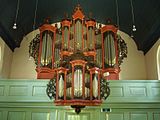
|
II / P | 22nd | Extension of the organ by Anthonie Verbeeck (1631) by an independent pedal with 6 registers; 1861 after Peize (NL), Herv. Kerk (photo), convicted; Case, prospectus and four to six registers received from Schnitger; other old registers taken from Schnitger; 1973/1981 restored by Gebr. Van Vulpen |
| 1693-1698 | Bremen | Bremen Cathedral | III / P | 50 | Replaced from 1847–1849 by a new building by Johann Friedrich Schulze | |
| 1694-1698 | Magdeburg | Holy Spirit Church | II / P | 26th | 1737 transferred to Groß Quenstedt , where it was rebuilt several times; Transferred to Wegeleben in 1978 , where it was almost completely burned in 1982 | |
| 1695-1698 | Bremen | St. Stephani | III / P | 42 | Burned in 1754 | |
| 1697 - 1698 | Golzwarden | St. Bartholomew | II / P | 20th | Housing preserved; today II / P / 22 | |
| 1697 - 1698 | Dedesdorf-Eidewarden | St. Laurence | II / p | 12 | Manual case and ten registers preserved; today II / P / 18; 1998–1999 restored by Orgelbau Führer (Heiko Lorenz) → Organ by St. Laurentius (Dedesdorf) |
|
| 1697 - 1698 | Strückhausen | St. John | II / p | 12 | Replaced in 1914 by a new building by Johann Martin Schmid ; Hauptwerk case preserved in modified form; today II / P / 15 | |
| 1696-1699 | Lübeck | Lübeck Cathedral | III / P | 45 | Replaced from 1892–1893 by a new building by Eberhard Friedrich Walcker ; Schnitger's preserved prospectus was destroyed in the air raid on Lübeck on March 29, 1942 ; Reconstruction of the Schnitger organ planned. | |
| 1696-1699 | Pieterburen (NL) (today in Mensingeweer ) | Dorpskerk | I. | 8th | 1901 after Mensingeweer (NL), Herv. Kerk, convicted; Housing, prospectus and six registers preserved; today I / p / 9; Restored 2010–2011 by Mense Ruiter → Organ of the Dorpskerk Mensingeweer |
|
| 1699 | Groningen (NL) | Lutheran Kerk | II / p | 16 | Replaced in 1896 by a new building for the “ P. van Oeckelen & Zonen” company; Reconstructed in 2017 by Bernhardt Edskes | |
| 1695-1699 | Achim | St. Laurence | II / P | 24 | Cost: 800 Reichstaler , demolition after a resolution of the church council of 1888 | |
| 1699 | Ganderkesee | St. Cyprian and Cornelius | II / p | 16 | Housing, prospectus and nine registers preserved; today II / P / 22; 2005 restored by Heiko Lorenz → organ by St. Cyprian and Cornelius (Ganderkesee) |
|
| 1698-1700 | Szczecin | Jacob's Cathedral | III / P | 46 | Completion of the new organ by Matthias Schurig after his death in 1697; Destroyed in 1944 | |
| 1698-1700 | Magdeburg | St. Ulrich and Levin Church | III / P | 49 | Replaced in 1899 by a new building designed by Wilhelm Rühlmann | |
| 1699-1700 | Dargun | Dargun Castle | II / P | 22nd | Destroyed in 1945 | |
| 1699-1701 | Buxtehude | St. Petri | III / P | 36 | Destroyed by lightning struck the tower in 1853; 25 pipes received, which were integrated in the new organ by Furtwängler (1859) | |
| 1700-1701 | Uithuizen (NL) | Jacobikerk | II / P | 28 | Case, 18 registers completely and three more partially preserved; 1987 and 2000/2001 restored by Bernhardt Edskes → Organ of the Jacobikerk Uithuizen |
|
| 1701 | Moreira (Maia) (Portugal) | San Salvador Monastery Church | II | 12 | Housing and 11 registers preserved; 2000–2001 restored by Georg Jann and Christoph Metzler → Organ from São Salvador (Maia de Moreira) |
|
| 1699-1702 | Clausthal-Zellerfeld | St. Salvatoris Church | III / P | 55 | Housing preserved; 1912 internal works replaced; 1969/1970 new building by Karl Schuke (II / P / 27, two free loops) | |
| 1700-1702 | Groningen (NL) | Academiekerk (today in Der Aa-kerk ) | III / P | 32 | 1815–1816 transferred to Der Aa-kerk; Case, prospectus and about 13 registers from Schnitger preserved; ten other old registers taken from Schnitger; today III / P / 40; 1997–2011 outsourcing and consolidation by Orgelmakerij Reil → Orgeln der Aa-kerk (Groningen) |
|
| 1702 - | Estebrugge (Jork) | St. Martini | II / P | 34 | Housing received | |
| after 1702 | Kiel | Kiel Castle | II | 19th | Burned in 1838 | |
| 1704 | Eenum (NL) | Dorpskerk | I. | 10 | Case, prospectus and five registers completely and two partially preserved; today I / p / 10; 1987 restored by Reil → Organ of the Dorpskerk Eenum |
|
| 1704 | Godlinze (NL) | Dorpskerk | II / p (?) | 16 | 1785 conversion by Albertus Antonius Hinsz into a one-manual work (I / p / 12); Case, prospectus and seven registers completely preserved and four partially preserved; 1986 restored by Reil to the condition of 1785 → organ of the Dorpskerk Godlinze |
|
| 1705 | Accum | St. Willehad | II / p | 14th | Housing preserved; today II / P / 14 | |
| 1706 | Berlin-Charlottenburg | Charlottenburg Palace (Eosander Chapel) | II / P | 26th | Destroyed in 1944 despite being moved to the Berlin Palace | |
| 1707 | Berlin | St. Sebastian | II / P | 24 | 1773-1774 by building new Ernst Julius Marx replaced | |
| 1706-1708 | Berlin | St. Nicholas Church | III / P | 40 | Replaced from 1845–1846 by a new building by Carl August Buchholz | |
| 1707-1708 | Hamburg-St. Georg (today in Lenzen ) | St. Georg, Church of the St. Georg Hospital (today St. Katharinen) | II / P | 27 | St. George's Church demolished in 1748 due to dilapidation / new building elsewhere. Organ 1744–1747 transferred to St. Katharinen in Lenzen (Elbe); Case partially preserved and two to three registers from Schnitger, five registers taken over from Hans Scherer the Younger ; Restored from 2005–2007 by Reinhard Hüfken | |
| 1707-1708 | Hamburg- Ochsenwerder | St. Pancras | II / P | 30th | Housing, prospectus and five to eleven registers preserved; today II / P / 24; 1966 New construction by Rudolf von Beckerath including the Schnitger registers → organ by St. Pankratius (Ochsenwerder) |
|
| 1707-1709 | Flensburg | Nikolaikirche | III / P | 42 |
Extension conversion of the organ by Nikolaus Maaß (1604–1609); Replaced in 1922 by a new building designed by Wilhelm Sauer ; Reconstructed in 2009 behind the historical prospectus → Organ of the Nikolaikirche (Flensburg) |
|
| 1709-1710 | Weener | Evangelical Reformed Church | II / p | 22nd | Housing and six registers preserved; today II / P / 29; 1972–1978 by Hendrik Jan Vierdag and 1978–1983 restored by Jürgen Ahrend → Organ of the Evangelical Reformed Church (Weener) |
|
| 1710-1711 | Pellworm | Old church | II / P | 24 | Housing and eleven registers (in whole or in part) preserved; 1987–1989 restored by Gebr. Hillebrand → organ of the old church (Pellworm) |
|
| 1710-1711 | Sneek (NL) | Martinikerk | III / P | 36 | Case, prospectus and four registers completely and six partially preserved; 1988 restored by Bakker & Timmenga → organ of the Martinikerk (Sneek) |
|
| 1711 | Ferwert (NL) | Hervormde Kerk | II / P | 26th | Almost completely replaced in 1872 by a new building by the Adema Brothers; five registers received from Schnitger | |
| around 1712 | Lisbon , Portugal (now in Mariana (Brazil) ) | Franciscan Church | II / p | 19th | Presumably built by Schnitger's colleague Heinrich Hulenkampf; In 1752 transferred to the Cathedral of Mariana in Brazil; Case, prospectus, 14 registers completely and two partially preserved. Restored in 1984 by Rudolf von Beckerath organ builder and in 2001 by Bernhardt H. Edskes. → Organ of the Cathedral of Mariana |
|
| 1710-1713 | Remove | St. Laurence | II / P | 24 | Housing, prospectus and three registers in the new building were preserved by Alfred Führer (1962) | |
| 1712-1714 | Hamburg | St. Michaelis | III / P | 52 | Destroyed in 1750 by a church fire after a lightning strike | |
| 1713-1714 | Empty | Luther Church | II / p | 18th | Replaced in 1795 by a new building by Hinrich Just Müller | |
| 1714-1716 | Rendsburg | Christ Church |

|
II / P | 29 | Housing and four registers in the new building preserved by Karl Schuke (1973); today IV / P / 51 |
| 1715-1716 | Faro (Portugal) | cathedral | II / p | 22nd | Presumably built or even built by Schnitger's colleague Heinrich Hulenkampf; rebuilt and expanded after damage from earthquake in 1767; Most of the case, eight complete registers and three partially preserved; Restored 1972–1973 by Dirk Andries Flentrop and 2006 by Dinarte Machado → Organ of Faro Cathedral |
|
| 1715-1719 | Itzehoe | St. Laurentii |
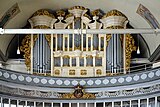
|
III / P | 43 |
Completed by Lambert Daniel Kastens ; Replaced by a new building in 1948, housing and brochure preserved; today IV / P / 58 → organ of the town church St. Laurentii (Itzehoe) |
| 1719-1721 | Zwolle (NL) | Michaelskirche | IV / P | 64 | Completed by the sons Franz Caspar Schnitger and Johann Georg Schnitger; Case and most of the registers from Schnitger preserved; since 2008 restoration in several phases → organ of Michaelskirche (Zwolle) |
Remarks:
- ↑ a b Organ Tours of Brasil and International Congress Brazil-Europe , accessed on November 24, 2017.
- ↑ www.orgaodase.com , accessed November 24, 2017.
Commemoration
- In 1948 a street in Neuenfelde was named "Arp-Schnitger-Stieg" on the occasion of Schnitger's 300th birthday. In Beverstedt , Grasberg, Cappel, Oldenburg and Jever there is an "Arp-Schnitger-Straße", in Strande an "Arp-Schnitger-Weg", in Ganderkesee an "Arp-Schnitger-Platz".
- In 1989 the Deutsche Bundespost issued the stamp “300 years of the Arp Schnitger organ in the St. Jacobi Church, Hamburg” with the slightly stylized image of the organ.
- On April 9, 1991, the German astronomer Freimut Börngen discovered the asteroid 29203 Schnitger at the Thuringian State Observatory Tautenburg ( IAU code 033) in Thuringia , which is part of the main asteroid belt .
- In 2003 (2nd edition 2006) Wolfgang Krause, Wennerstorfer Filmwerkstatt, released a DVD “The Arp Schnitger Organ in Neuenfelde”, which traces Schnitger's life and introduces the Neuenfeld organ.
- On the occasion of the 300th anniversary of Arp Schnitger's death in 2019, the “Orgelstadt Hamburg” association was founded and the state of Lower Saxony is organizing an anniversary year with almost 200 concerts and activities.
literature
chronologically ascending
- Gustav Fock : Arp Schnitger and his school. A contribution to the history of organ building in the North and Baltic Sea coast areas . Bärenreiter, Kassel 1974, ISBN 3-7618-0261-7 (basic monograph on life and work, with bibliography).
- Helmut Winter : The Schnitger organ in Cappel. St. Petri and Pauli . Wagner, Hamburg 1977, ISBN 3-921029-52-X ( arpschnitger.nl [PDF; 2.9 MB ]).
- Helmut Winter, Cor [= Cornelius] H. Edskes, Heinz Meyer-Bruck: The Huss organ in Stade, St. Cosmae . Verlag der Musikalienhandlung Wagner, Hamburg 1979, ISBN 978-3-921029-51-0 .
- Peggy Kelley Reinburg: Arp Schnitger, organ builder, catalyst for the centuries . Indiana University Press, Bloomington 1982, ISBN 0-253-30927-1 .
- Cornelius H. Edskes : Het organ van de Martinikerk te Groningen . In: Het Orgel . tape 81 , 1985, pp. 282-286 .
- Marcello Martiniano Ferreira: Arp Schnitger. Dois orgãos congeneres de 1701. Suas destinaçoes atuais e características tecnicas . Niterói, Rio de Janeiro 1991 (Portuguese, dissertation).
- Ulrich Bitz: On the verge of knowledge. Hans Henny Jahnn and organ building . In: Heimo Reinitzer (Hrsg.): The Arp Schnitger organ of the main church St. Jacobi in Hamburg . Christians, Hamburg 1995, ISBN 3-7672-1187-4 , pp. 94-126 .
- Harald Vogel , Günter Lade, Nicola Borger-Keweloh: Organs in Lower Saxony . Hauschild Verlag, Bremen 1997, ISBN 3-931785-50-5 (with bibliography).
- Peter A. Golon: And yet it was! Schnitger and Basedow. News about the founding years of a style-forming organ building workshop . In: Ars Organi . tape 46 , 1998, pp. 74-78 ( arpschnitger.nl ).
- Bert Veening (Ed.): 350 Jaar Arp Schnitger . Stichting Groningen Orgelland, 1998, ISSN 0168-1893 .
- Stef Tuinstra : Arp Schnitger - looking for the authentic sound . In: Basler Jahrbuch für historical Musikpraxis . tape 22/1998 . Amadeus Verlag, Winterthur 1999, p. 157-178 .
- Albrecht Schneider, Richard von Busch, Lüder Schmidt: Sound analyzes on Arp Schnitger organs . In: "Critica musica". Studies of the 17th and 18th centuries. Festschrift for Hans-Joachim Marx . Metzler, Stuttgart / Weimar 2001, ISBN 3-476-45261-1 , p. 174-192 .
- Ibo Ortgies , Frank van Wijk: “Reyne Harmonie” in Alkmaar. Stemming en temperatuur in Nederland in de 17de en 18de eeuw . In: Het Orgel . tape 99 , no. 3 , 2003, p. 12–36 (With bibliography. The article refers both to the temperature of the Alkmaar organ and to the vocal practice of the Schnitger School and the Netherlands in general).
- Uwe Pape , Winfried Topp: organs and organ builders in Bremen . 3. Edition. Pape, Berlin 2003, ISBN 3-921140-64-1 .
- Joel Speerstra (Ed.): The North German Organ Research Project at Göteborg University . University of Gothenburg, Gothenburg 2003, ISBN 91-972612-1-1 .
- Peter van Dijk: A pronkjuweel op het Hogeland. Het Arp Schnitger-Orgel te Uithuizen . Walburg, Zutphen 2004, ISBN 90-5730-310-8 .
- Ibo Ortgies: The practice of organ tuning in northern Germany in the 17th and 18th centuries and its relationship to contemporary music practice . 2nd revised edition. Göteborgs universitet, Göteborg 2007 ( ibo.ortgies.googlepages.com - first edition: 2004).
- Ibo Ortgies: Arp Schnitger . In: Ludwig Finscher (Hrsg.): The music in past and present . Person part . tape 14 . Bärenreiter, Kassel 2005, Sp. 1529–1532 (The baptism date given there is incorrectly given as February 9, 1648; the correct date is July 9, 1648).
- Jürgen Ehlers: Schnitger, Arp (1648–1719) . In: Douglas E. Bush, Richard Kassel (Eds.): The Organ. To Encyclopedia . Routledge, New York / London 2006, ISBN 0-415-94174-1 , pp. 496–497 ( limited preview in Google Book search).
- Ibo Ortgies: A Meeting of Two Temperaments. Andreas Werckmeister and Arp Schnitger . In: Thomas Donahue (Ed.): Music and Its Questions. Essays in Honor of Peter Williams . OHS Press, Richmond / VA 2007, p. 75-99 .
- Ibo Ortgies: Schnitger, Arp. In: New German Biography (NDB). Volume 23, Duncker & Humblot, Berlin 2007, ISBN 978-3-428-11204-3 , pp. 326-328 ( digitized version ).
- Peter A. Golon: Arp Schnitger. Life and work . In: Yearbook of the Altländer Archive . 2008, ISSN 0947-4277 , p. 32-40 .
- Fritz Schild: Organ atlas of the historical and modern organs of the Evangelical Lutheran Church in Oldenburg . Florian Noetzel, Wilhelmshaven 2008, ISBN 978-3-7959-0894-2 .
- Konrad Küster : Arp Schnitger's year 1682 and the consequences. Workshop formation, marriage process and initiation music . In: Music & Church . tape 9 , no. 1 , 2010, ISSN 0027-4771 , p. 32-36 .
- Cornelius H. Edskes, Harald Vogel: Arp Schnitger and his work . 2nd revised edition. Hauschild Verlag, Bremen 2013, ISBN 978-3-89757-326-0 (first edition: 2009, standard work of the Arp Schnitger Society and the Stichting Groningen Orgelland, which inventories all 45 organs preserved.).
- Ibo Ortgies: Schnitger . In: Uwe Pape, Wolfram Hackel (Hrsg.): Lexikon Norddeutscher Orgelbauer . 3 (Saxony-Anhalt and the surrounding area). Pape Verlag Berlin, Berlin 2015, p. 505-509 .
- Ibo Ortgies: Recent Research on Schnitger Organs. New Findings and Attributions . In: Keyboard Perspectives. The Yearbook of the Westfield Center for Historical Keyboard Studies . tape 9 , 2016, ISSN 1943-0809 , p. 119–150 (German: unknowns about Schnitger organs. Notes, finds, hypotheses, attributions . 2016. Translated by Ibo Ortgies and James F. Wallmann, Ndl. Version [translated by Jan Smelik]: Nieuws over Schnitger. Aanwijzigingen , vondsten, observaties, hypothesen en toeschrijvingen. In: Het Orgel. Volume 111, 2016, Issue 1, pp. 3–11, and Issue 2, pp. 3–9; Original in: Ars Organi. Volume 64, 2016, Book 1, pp. 24-33, and Book 2, pp. 83-89).
- Dietrich Diederichs-Gottschalk: My sound points to eternity. The image programs for organ lofts and church furnishings in the St. Bartholomäuskirche Golzwarden and the St. Pankratiuskirche Hamburg-Neuenfelde in the context of the organs by Arp Schnitger . Isensee, Oldenburg 2017, ISBN 978-3-7308-1404-8 .
- Horst Hollmann: Arp Schnitger gets a face ; Johann Haddinga : Arp Schnitger and his traces in the world of sound. In: Ostfriesland Magazin, 1/2018, SKN Druck und Verlag, Norden 2017, p. 78 ff.
- Horst Hollmann: The sound of slowness. In 2019, the Arp Schnitger Society will celebrate the organ builder's 300th year of death. In: Jeversches Wochenblatt of January 5, 2018, p. 27.
- Jan von Busch: The lost Schreiber organ in Koldenbüttel and its organ-building organists . In: Ars Organi . tape 66 , no. 2 , 2018, p. 73–82 (On pp. 78–80, the article deals with details of the Schnitger organs of the St. Pauli Church in Hamburg-Altona (1687, replaced 1718–1721 by Otto Diederich Richborn's new building) and the positive in Bergstedt (1686 or later)).
- Lore Timme-Hansel: Legendary master of organ sound. In: Jeversches Wochenblatt of December 31, 2018, p. 33.
- Holger Bloem (text), Martin Stromann, Ute Bruns (photos): Where Bach sounds like the sea. In: Ostfriesland Magazin. 6/2019. SKN Druck und Verlag, Norden 2019, p. 43 ff.
- Lynn Edwards: Schnitger, Arp. In: Grove Music Online (English; subscription required).
- Konrad Küster : Arp Schnitger. Organ builder - sound architect - thought leader, 1648–1719 . Verlag Ludwig, Kiel 2019, ISBN 978-3-86935-358-6 (comprehensive biography).
- Martin Stolzenau: Arp Schnitger: world-class organ builder. In: Heimat am Meer , supplement to Wilhelmshavener Zeitung , No. 15/2019, from July 20, 2019, p. 58 ff.
- Reinhard Ruge: The Arp Schnitger organ in the Ludgerikirche in the north (East Frisia) . Florian Isensee, Oldenburg 2019, ISBN 978-3-7308-1550-2 , (including Jürgen Ahrend : restoration report with photos , pp. 82–128).
Discography
- Arp Schnitger in Lower Saxony. 2nd Edition. 2014. Music production Dabringhaus and Grimm, 1831-2. 2 CDs. (All twelve Schnitger organs in Lower Saxony, presented by an international team of young organists under the artistic direction of Harald Vogel).
- Arp Schnitger in Nederland. 2003. Stichting Groningen Orgelland 0031. 2 CDs (all Schnitger organs in the Netherlands, presented by organists V. van Laar, L. Lub, J. de Vries and S. de Vries under the artistic direction of Cor H. Edskes)
- Discography striving for completeness
Web links
- Literature by and about Arp Schnitger in the catalog of the German National Library
- Works by and about Arp Schnitger in the German Digital Library
- Arp Schnitger database from GOArt
- Niels Juister: Arp Schnitger organ landscape in the Lower Saxony Monument Atlas
- Organ city Hamburg: Arp Schnitger - life and work (multimedia website on Arp Schnitger's life, work and aftermath with virtual "PLAY ARP" organ)
- Arp Schnitger Society (with information on life and work)
- Arp Schnitger organs (English & Dutch, with lots of photos and information)
- Page by H.-W. Coordes (with overview map and detailed information on all organs)
- TV interview with Harald Vogel and Hans Davidsson
- Arp Schnitger in the culture portal Northwest .
- Walter Liedtke: July 28, 1719 - anniversary of the death of the organ builder Arp Schnitger WDR ZeitZeichen (podcast).
Individual evidence
- ↑ Gustav Fock: Arp Schnitger and his school. A contribution to the history of organ building in the North and Baltic Sea coast areas . Bärenreiter, Kassel 1974, ISBN 3-7618-0261-7 , p. 17 . Fock presumably took the date of birth from Siwert Meijer's report; s. ibid, p. 283.
- ↑ Peter A. Golon: Arp Schnitger. Life and work . In: Yearbook of the Altländer Archive . 2008, ISSN 0947-4277 , p. 33 f .
- ↑ a b Peter A. Golon: Arp Schnitger. Life and work . In: Yearbook of the Altländer Archive . 2008, ISSN 0947-4277 , p. 34 .
- ↑ Gustav Fock: Arp Schnitger and his school. A contribution to the history of organ building in the North and Baltic Sea coast areas . Bärenreiter, Kassel 1974, ISBN 3-7618-0261-7 , p. 15th f .
- ↑ Introduction to Arp Schnitger (English), accessed on November 24, 2017.
- ↑ Edskes, Vogel: Arp Schnitger and his work. 2nd edition 2013, p. 18.
- ↑ a b c d e Jürgen Ehlers: Schnitger, Arp (1648–1719) . In: Douglas E. Bush, Richard Kassel (Eds.): The Organ. To Encyclopedia . Routledge, New York, London 2006, ISBN 0-415-94174-1 , pp. 496–497 ( limited preview in Google Book search).
- ↑ Peter A. Golon: Arp Schnitger. Life and work . In: Yearbook of the Altländer Archive . 2008, ISSN 0947-4277 , p. 34 .
- ↑ Richert, Harald: Arp Schnitger and Vincent Lübeck in our home . In Lichtwark booklet No. 64. Ed .: Bergedorf district office, Bergedorf, 1999. See now: Verlag HB-Werbung, Hamburg-Bergedorf. ISSN 1862-3549 .
- ↑ Gustav Fock: Arp Schnitger and his school. A contribution to the history of organ building in the North and Baltic Sea coast areas . Bärenreiter, Kassel 1974, ISBN 3-7618-0261-7 , p. 264 .
- ↑ Edskes, Vogel: Arp Schnitger and his work. 2nd edition 2013, p. 178.
- ↑ Gustav Fock: Arp Schnitger and his school. A contribution to the history of organ building in the North and Baltic Sea coast areas . Bärenreiter, Kassel 1974, ISBN 3-7618-0261-7 , p. 49 . According to the Nikolai organist Johann Friedrich Schwencke (1792–1852), chorale book for the Hamburg hymn book (1832).
- ↑ Edskes, Vogel: Arp Schnitger and his work. 2nd edition 2013, p. 14.
- ↑ Fock: Arp Schnitger and his school. 1974, pp. 263, 272-277. Ortgies: unknowns about Schnitger organs. Notes, finds, hypotheses, ascriptions. 2016.
- ↑ Edskes, Vogel: Arp Schnitger and his work. 2nd edition 2013, p. 179.
- ↑ James Boeringer: Organa Britannica. Organs in Great Britain 1660-1860. A Complete Edition of the Sperling Notebooks and Drawings in the Library of the Royal College of Organists, vol. 3 . Bucknell University Press, Lewisburg, PA (USA) 1989, pp. 289 . This organ was given a new case in 1770 and moved to the nearby Christ Church in Derry Hill in 1842.
- ↑ Edskes, Vogel: Arp Schnitger and his work. 2nd edition 2013, p. 147.
- ↑ a b c Ibo Ortgies: Arp Schnitger . In: Ludwig Finscher (Hrsg.): The music in past and present. Person part . tape 14 . Bärenreiter, Kassel 2005, Sp. 1529 .
- ↑ Peter A. Golon: Arp Schnitger. Life and work . In: Yearbook of the Altländer Archive . 2008, ISSN 0947-4277 , p. 37, 39 .
- ↑ Peter A. Golon: Arp Schnitger. Life and work . In: Yearbook of the Altländer Archive . 2008, ISSN 0947-4277 , p. 36 . Cf. Julius Quast: “On the history of the» Orgelbauerhof «” in the appendix by Helmut Winter: The Schnitger organ in Cappel. St. Petri and Pauli . Wagner, Hamburg 1977, ISBN 3-921029-52-X , p. 19th f . ( arpschnitger.nl [PDF; 3.0 MB ]).
- ↑ a b Edskes, Vogel: Arp Schnitger and his work. 2nd edition 2013, p. 15.
- ↑ Gustav Fock: Arp Schnitger and his school. A contribution to the history of organ building in the North and Baltic Sea coast areas . Bärenreiter, Kassel 1974, ISBN 3-7618-0261-7 , p. 264 f .
- ^ Text book of the CD Arp Schnitger in Lower Saxony . Music production Dabringhaus and Grimm, 1124-2, 2002, p. 61f.
- ↑ Gustav Fock: Arp Schnitger and his school. A contribution to the history of organ building in the North and Baltic Sea coast areas . Bärenreiter, Kassel 1974, ISBN 3-7618-0261-7 , p. 131 .
- ↑ Dietrich Diederichs-Gottschalk : My sound points to eternity. The image programs for organ lofts and church furnishings in the St. Bartholomäuskirche Golzwarden and the St. Pankratiuskirche Hamburg-Neuenfelde in the context of the organs by Arp Schnitger. Isensee, Oldenburg 2017, ISBN 978-3-7308-1404-8 , advocates identification, Ibo Ortgies : Een portret van Arp Schnitger? In: Het Orgel . Volume 113, No. 2, 2017, pp. 41-47, argues against it.
- ↑ Horst Hollmann: Arp Schnitger gets a face. NWZ online, accessed January 27, 2017.
- ↑ a b arp-schnitger-gesellschaft.de: Life and work. Website of the Arp Schnitger Society, accessed on November 24, 2017.
- ↑ Werckmeister: Extended and Improved Organ Rehearsal : “Praise” (online) , accessed on November 24, 2017.
- ↑ Gustav Fock: Arp Schnitger and his school. A contribution to the history of organ building in the North and Baltic Sea coast areas . Bärenreiter, Kassel 1974, ISBN 3-7618-0261-7 , p. 268 .
- ↑ Peter A. Golon: Arp Schnitger. Life and work . In: Yearbook of the Altländer Archive . 2008, ISSN 0947-4277 , p. 38 .
- ↑ Gustav Fock: Arp Schnitger and his school. A contribution to the history of organ building in the North and Baltic Sea coast areas . Bärenreiter, Kassel 1974, ISBN 3-7618-0261-7 , p. 269 .
- ^ Peggy Kelley Reinburg: Arp Schnitger, organ builder, catalyst for the centuries . Indiana University Press, Bloomington 1982, ISBN 0-253-30927-1 , pp. 42 .
- ↑ Siwert Meijer: Bijdragen tot de geschiedenis van het maken organ. In: Caecilia. 1853/54; Translation in Gustav Fock: Arp Schnitger and his school. A contribution to the history of organ building in the North and Baltic Sea coast areas . Bärenreiter, Kassel 1974, ISBN 3-7618-0261-7 , p. 282-289 .
- ↑ Quoted from Gustav Fock: Arp Schnitger and his school. A contribution to the history of organ building in the North and Baltic Sea coast areas . Bärenreiter, Kassel 1974, ISBN 3-7618-0261-7 , p. 282 f . (Translation from Dutch).
- ↑ Peter A. Golon: Arp Schnitger. Life and work . In: Yearbook of the Altländer Archive . 2008, ISSN 0947-4277 , p. 38 . Peggy Kelley Reinburg: Arp Schnitger, organ builder, catalyst for the centuries . Indiana University Press, Bloomington 1982, ISBN 0-253-30927-1 , pp. 49 .
- ↑ Gustav Fock: Arp Schnitger and his school. A contribution to the history of organ building in the North and Baltic Sea coast areas . Bärenreiter, Kassel 1974, ISBN 3-7618-0261-7 , p. 271 .
- ↑ The new buildings and extensions are given in brackets according to the list of works by Gustav Fock: Arp Schnitger und seine Schule. A contribution to the history of organ building in the North and Baltic Sea coast areas . Bärenreiter, Kassel 1974, ISBN 3-7618-0261-7 , p. 272-277 . A few more works have to be added to the list, such as B. Hamburg (St. Georgen, 1707-1708) and Berlin (St. Sophien, 1714).
- ↑ a b c d Harald Vogel, Günter Lade, Nicola Borger-Keweloh: Organs in Lower Saxony . Hauschild Verlag, Bremen 1997, ISBN 3-931785-50-5 , p. 160 .
- ^ Ibo Ortgies: Arp Schnitger . In: Ludwig Finscher (Hrsg.): The music in past and present. Person part . tape 14 . Bärenreiter, Kassel 2005, Sp. 1530 .
- ↑ Edskes, Vogel: Arp Schnitger and his work. 2nd edition 2013, p. 210.
- ↑ See introduction by HW Coordes and Harald Vogel, Günter Lade, Nicola Borger-Keweloh: Orgeln in Niedersachsen . Hauschild Verlag, Bremen 1997, ISBN 3-931785-50-5 , p. 160 f .
- ↑ On the wood used and the organ metal cf. Gustav Fock: Schnitger, Arp . In: Music in the past and present . 1st edition. tape 11 . Bärenreiter, Kassel 1963, p. 1915 . For the craft level cf. Harald Vogel, Günter Lade, Nicola Borger-Keweloh: Organs in Lower Saxony . Hauschild Verlag, Bremen 1997, ISBN 3-931785-50-5 , p. 160 .
- ^ Peggy Kelley Reinburg: Arp Schnitger, organ builder, catalyst for the centuries . Indiana University Press, Bloomington 1982, ISBN 0-253-30927-1 , pp. 103 . Stef Tuinstra: Arp Schnitger - looking for the authentic sound . In: Basler Jahrbuch für historical Musikpraxis . tape 22/1998 . Amadeus Verlag, Winterthur 1999, p. 175 .
- ^ Harald Vogel , Günter Lade, Nicola Borger-Keweloh: Organs in Lower Saxony . Hauschild Verlag, Bremen 1997, ISBN 3-931785-50-5 , p. 256 .
- ↑ Edskes, Vogel: Arp Schnitger and his work. 2nd edition 2013, p. 9.
- ^ Ibo Ortgies: Arp Schnitger . In: Ludwig Finscher (Hrsg.): The music in past and present. Person part . tape 14 . Bärenreiter, Kassel 2005, Sp. 1531 . Peggy Kelley Reinburg: Arp Schnitger, organ builder, catalyst for the centuries . Indiana University Press, Bloomington 1982, ISBN 0-253-30927-1 , pp. 102 .
- ↑ See e.g. B. the organ in Cappel with its numerous, originally preserved mixed voices , see in detail Helmut Winter: The Schnitger organ in Cappel. St. Petri and Pauli . Wagner, Hamburg 1977, ISBN 3-921029-52-X ( arpschnitger.nl [PDF; 3.0 MB ]).
- ↑ Stef Tuinstra: Arp Schnitger - in search of the authentic sound . In: Basler Jahrbuch für historical Musikpraxis . tape 22/1998 . Amadeus Verlag, Winterthur 1999, p. 162 f .
- ↑ Before 1740, no organs that were not tuned to the middle note were recorded in northern Germany. See Ibo Ortgies: The Practice of Organ Tuning in Northern Germany in the 17th and 18th Centuries and its Relationship to Contemporary Music Practice . Göteborgs universitet, Göteborg 2007, p. 195-204 (revised version). This also applies to the organs by Frans Caspar Schnitger in Alkmaar and Zwolle, see ibid., Pp. 117–146, and Ibo Ortgies, Frank van Wijk: “Reyne Harmonie” in Alkmaar. Stemming en temperatuur in Nederland in de 17de en 18de eeuw . In: Het Orgel . tape 99 , no. 3 , 2003, p. 12-36 .
- ↑ Stef Tuinstra: Arp Schnitger - in search of the authentic sound . In: Basler Jahrbuch für historical Musikpraxis . tape 22/1998 . Amadeus Verlag, Winterthur 1999, p. 167 f . A nice example is the organ of the Grasberg Church , which was transferred from Hamburg in 1788.
- ↑ Gustav Fock: Arp Schnitger and his school. A contribution to the history of organ building in the North and Baltic Sea coast areas . Bärenreiter, Kassel 1974, ISBN 3-7618-0261-7 , p. 278-281 .
- ↑ Edskes, Vogel: Arp Schnitger and his work. 2nd edition 2013, p. 196.
- ↑ Ortgies: Schnitger. In: Lexicon of North German Organ Builders. 2015, p. 509.
- ↑ Stef Tuinstra: Arp Schnitger - in search of the authentic sound . In: Basler Jahrbuch für historical Musikpraxis . tape 22/1998 . Amadeus Verlag, Winterthur 1999, p. 173-175 .
- ↑ Cf. Ulrich Bitz: On the edge of knowledge. Hans Henny Jahnn and organ building . In: Heimo Reinitzer (Hrsg.): The Arp Schnitger organ of the main church St. Jacobi in Hamburg . Christians, Hamburg 1995, p. 107-118 .
- ↑ Edskes, Vogel: Arp Schnitger and his work. 2nd edition 2013, p. 13.
- ^ Copies of Schnitger organs , accessed on November 24, 2017.
- ^ Ibo Ortgies: Arp Schnitger . In: Ludwig Finscher (Hrsg.): The music in past and present. Person part . tape 14 . Bärenreiter, Kassel 2005, Sp. 1531 .
- ↑ Homepage of the Arp Schnitger Society , accessed on November 24, 2017.
- ↑ Stichting Groningen Orgelland , accessed on November 24, 2017.
- ↑ Weser-Kurier of September 11, 2012: World Heritage Initiative for Schnitger Organs is taking shape , accessed on November 24, 2017.
- ↑ Information compiled from Gustav Fock: Arp Schnitger and his school. A contribution to the history of organ building in the North and Baltic Sea coast areas . Bärenreiter, Kassel 1974, ISBN 3-7618-0261-7 . Fritz Schild: Organ atlas of the historical and modern organs of the Evangelical Lutheran Church in Oldenburg . Florian Noetzel, Wilhelmshaven 2008, ISBN 978-3-7959-0894-2 . Harald Vogel, Günter Lade, Nicola Borger-Keweloh: Organs in Lower Saxony . Hachiauschild Verlag, Bremen 1997, ISBN 3-931785-50-5 . Arp Schnitger (NL) and H.-W. Coordes , accessed November 24, 2017.
-
↑ Schnitger's organ in St. Ludgeri, Norden, has three manual keyboards, but they serve four manual works:
I: Rückpositiv, II. Werck (main work), III. Breastwork and / or upper positive.
Since the wind is supplied to all manual works through their own valves, Schnitger was able to assign the third manual to the two last-named parts, which can sound individually or together (the manual slide coupler allows registers from W, BP and OP to be pulled together in any combination). This system, unique for Schnitger, was created in 1691–1692 when he added the upper positive to the organ that had been in existence for a number of years and - probably because of the existing breastwork - there was no space for a further, fourth manual keyboard. - ↑ Sound samples of the organ of the Grasberg Church , accessed on August 25, 2018.
- ↑ Jan von Busch: Arp Schnitger's house organ for Dr. Johann Friedrich Mayer. In: Ars Organi . Volume 62, 2014, Issue 3, pp. 141–147.
- ↑ nordkirche.de: Lübeck Cathedral is to get a new baroque organ , accessed on November 24, 2017.
- ^ 1989 stamp , accessed on November 24, 2017.
- ↑ DVD Arp Schnitger , accessed on November 24, 2017.
- ↑ Schnitger year: Land celebrates with 197 organ events at ndr.de on March 12, 2019
| personal data | |
|---|---|
| SURNAME | Schnitger, Arp |
| ALTERNATIVE NAMES | Schnitker, Arp |
| BRIEF DESCRIPTION | German organ builder |
| DATE OF BIRTH | baptized July 9, 1648 |
| PLACE OF BIRTH | Schmalenfleth , municipality of Brake (Unterweser) |
| DATE OF DEATH | buried July 28, 1719 |
| Place of death | unsure: Itzehoe |










